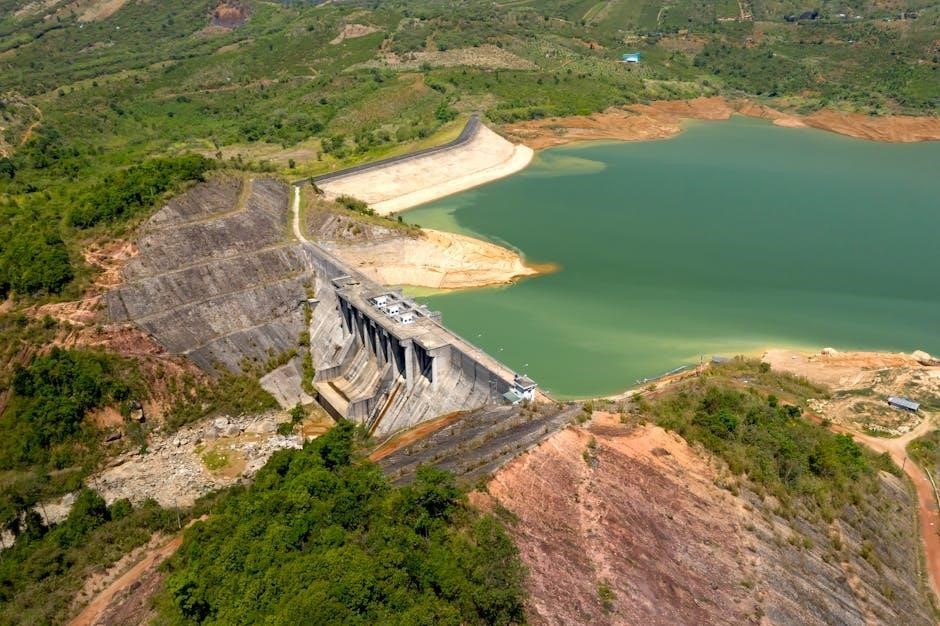guiding principles for managing wildlife resources
Wildlife resource management is a crucial field focused on maintaining biodiversity and ecological balance. It involves guiding principles that balance conservation with sustainable use, ensuring the long-term health of wildlife populations and their habitats.

Key Principles of Wildlife Resource Management
Wildlife resource management relies on principles of sustainability, ecological integrity, and social-economic balance. It ensures species conservation, maintains ecosystem services, and addresses human needs while preserving biodiversity for future generations;
1.1 Sustainable Use and Conservation
Sustainable use and conservation are cornerstone principles in wildlife management, ensuring resources are utilized without depletion. This approach balances human needs with ecological integrity, maintaining healthy populations and habitats. It emphasizes long-term planning to prevent overexploitation, integrating practices that support biodiversity and ecosystem services. By aligning human activities with natural cycles, sustainable use ensures wildlife thrives while meeting societal demands, fostering a harmonious relationship between conservation and utilization.
1.2 Ecological Integrity and Biodiversity

Ecological integrity and biodiversity are fundamental principles in wildlife management, focusing on preserving the natural balance of ecosystems. This principle ensures that wildlife populations and their habitats remain resilient and functional, supporting complex interactions within ecosystems. Maintaining biodiversity is critical, as it underpins ecosystem services essential for both wildlife and human well-being. Habitat preservation and restoration are key strategies to prevent fragmentation and ensure species can thrive. Additionally, managing human activities to minimize ecological disruptions is vital. Tools like remote sensing and GIS applications help monitor and protect critical habitats, ensuring the conservation of biodiversity. By prioritizing ecological integrity, wildlife management fosters healthy, self-sustaining ecosystems that support biodiversity and provide long-term benefits for future generations. This approach aligns with global conservation goals, such as those outlined by organizations like IUCN, emphasizing the importance of safeguarding nature’s intricate web of life.

1.3 Social and Economic Considerations
Social and economic considerations are integral to effective wildlife resource management. These principles ensure that wildlife management strategies align with the needs and aspirations of local communities while promoting sustainable development. Recognizing the economic value of wildlife, such as through ecotourism or regulated hunting, can generate revenue and incentivize conservation efforts. However, it is crucial to balance these activities with social equity, ensuring that benefits are shared fairly among stakeholders. Engaging local communities in decision-making processes fosters ownership and cooperation, reducing conflicts and enhancing the sustainability of management practices. Economic assessments and impact studies help identify optimal strategies that support both human livelihoods and wildlife conservation. By addressing social and economic dimensions, wildlife management becomes more inclusive and resilient, contributing to the well-being of both people and the planet. This holistic approach ensures that wildlife resources are managed in a way that is both equitable and economically viable.
Strategic Approaches to Wildlife Management
Strategic approaches to wildlife management involve integrating ecological, social, and economic factors to ensure sustainable use and conservation of resources. These methods balance human needs with biodiversity protection and ecological integrity.
2.1 Adaptive Management and Monitoring
Adaptive management and monitoring are cornerstone strategies in wildlife resource management, emphasizing flexibility and continuous improvement. These approaches involve systematically tracking ecological and social changes to refine management practices. By collecting and analyzing data, managers can assess the effectiveness of current strategies and make informed adjustments. This iterative process ensures that wildlife management remains responsive to dynamic environmental conditions and stakeholder needs. Monitoring also helps identify emerging challenges, such as habitat degradation or climate change impacts, allowing for timely interventions. Adaptive management fosters a culture of learning and collaboration, integrating scientific insights with local knowledge to optimize outcomes. Regular evaluation and feedback loops are essential to this process, ensuring that wildlife management remains aligned with long-term conservation and sustainability goals. Ultimately, adaptive management and monitoring enable resource managers to balance ecological integrity with human activities, promoting resilient ecosystems for future generations. This approach is critical for addressing uncertainties and improving the efficiency of wildlife conservation efforts.
2.2 Stakeholder Engagement and Participation
Stakeholder engagement and participation are vital components of effective wildlife resource management. Involving diverse stakeholders ensures that management decisions reflect the interests and needs of local communities, conservationists, policymakers, and other affected parties. This collaborative approach fosters trust and cooperation, which are essential for implementing sustainable practices. By engaging stakeholders early and continuously, managers can identify potential conflicts and develop solutions that balance competing demands. Community-based initiatives, for instance, empower local residents to take an active role in conservation efforts, enhancing the likelihood of long-term success. Additionally, stakeholder participation provides valuable insights and traditional knowledge, enriching management strategies. Open communication channels and inclusive decision-making processes are key to ensuring that all voices are heard. This principle not only strengthens the social acceptability of wildlife management plans but also enhances their ecological and economic viability, ultimately contributing to more equitable and resilient outcomes for both wildlife and human populations.

Technological and Scientific Tools
Technological advancements like remote sensing, GIS, and data analytics are essential for monitoring and managing wildlife resources effectively. These tools enhance accuracy, efficiency, and decision-making in conservation and sustainable resource management practices.
3.1 Remote Sensing and GIS Applications
Remote sensing and Geographic Information Systems (GIS) are powerful tools in wildlife resource management. These technologies enable the collection and analysis of large-scale data, such as habitat conditions, species distribution, and environmental changes. By utilizing satellite imagery, managers can monitor wildlife populations and track changes over time, ensuring sustainable practices. GIS mapping allows for the creation of detailed spatial models, helping to identify critical habitats and migration patterns. These tools are essential for developing conservation strategies and addressing challenges like habitat fragmentation. Additionally, remote sensing can detect illegal activities, such as deforestation or poaching, providing valuable insights for enforcement. The integration of GIS with field data enhances decision-making, ensuring that management plans are both effective and adaptive. Overall, remote sensing and GIS applications are indispensable for modern wildlife management, offering precise and scalable solutions to complex environmental issues.
3.2 Data Collection and Analysis Techniques
Data collection and analysis are fundamental to effective wildlife resource management. Techniques such as field surveys, camera traps, and sensor technologies provide valuable insights into species behavior, population dynamics, and habitat conditions. Statistical modeling and machine learning algorithms are increasingly used to analyze large datasets, identifying trends and patterns that inform conservation strategies. These methods enable managers to assess the impact of human activities on wildlife and develop targeted interventions. Advanced tools like telemetry and genetic analysis further enhance the accuracy of data, aiding in the design of sustainable management plans. By integrating diverse data sources, managers can make informed decisions that balance ecological, economic, and social priorities. Regular data reviews ensure adaptive management practices, fostering resilience and long-term conservation outcomes. Accurate and timely data analysis is essential for addressing challenges such as habitat loss and climate change, ensuring wildlife resources are managed equitably and sustainably for future generations.
Policy and Legislative Frameworks
Effective policies and legislation are crucial for sustainable wildlife management, balancing conservation with human needs. International agreements and national laws ensure ecological sustainability and equity, guiding responsible wildlife resource management.
4.1 National and International Policies
National and international policies play a pivotal role in wildlife resource management, establishing frameworks that balance conservation with sustainable use. International agreements, such as the Convention on International Trade in Endangered Species (CITES), regulate wildlife trade to prevent overexploitation. Meanwhile, national policies often focus on specific regional needs, incorporating local ecological and socio-economic contexts. These policies are designed to ensure the long-term survival of wildlife species and their habitats, promoting biodiversity and ecological integrity. They also address issues like human-wildlife conflicts and climate change impacts. By aligning with global sustainability goals, these policies provide a structured approach to managing wildlife resources effectively.
4.2 Role of Organizations in Wildlife Management
Organizations are essential in wildlife management, offering expertise, resources, and advocacy. International bodies like the IUCN and WWF develop guidelines and support conservation efforts globally. National organizations often implement these frameworks locally, ensuring adaptability to regional challenges. NGOs play a critical role in raising awareness and engaging communities. Governments collaborate with these entities to enforce policies and fund initiatives. Together, they address issues like habitat preservation and illegal wildlife trade, fostering sustainable practices and equitable solutions.

Ensuring Equity and Justice in Wildlife Management
Equity and justice in wildlife management involve fair distribution of benefits and responsibilities, ensuring all stakeholders, including local communities, have a voice and share in conservation efforts and resources sustainably.

5.1 Community-Based Conservation
Community-based conservation is a vital approach that empowers local communities to take an active role in managing and conserving wildlife resources. This method ensures that the needs and rights of local populations are integrated into conservation strategies, fostering equity and justice. By involving communities, it promotes a sense of ownership and responsibility, leading to more sustainable outcomes. Traditional knowledge and practices are valued and incorporated, ensuring cultural sensitivity and effectiveness. Equitable distribution of benefits, such as revenue from ecotourism or resource use, strengthens community support for conservation efforts. Collaboration between local stakeholders and external organizations is crucial, providing necessary resources and expertise. This approach not only enhances biodiversity protection but also addresses social and economic disparities, ensuring that wildlife management is both inclusive and beneficial for all parties involved. Ultimately, community-based conservation is a cornerstone of equitable and just wildlife resource management.
5.2 Addressing Human-Wildlife Conflicts
Addressing human-wildlife conflicts is a critical aspect of wildlife resource management, as these conflicts often arise from competing land use and resource needs. Effective strategies involve balancing human livelihoods with wildlife conservation goals. One key approach is the creation of wildlife corridors to reduce habitat fragmentation, minimizing encounters between humans and animals. Compensation schemes for crop damage or livestock losses can also alleviate tensions, encouraging coexistence. Community engagement and education are essential, as they foster understanding and support for conservation efforts. Additionally, adaptive management practices, such as monitoring conflict hotspots and implementing tailored solutions, ensure long-term effectiveness. By addressing these conflicts equitably, wildlife managers can promote harmonious coexistence between humans and wildlife, safeguarding biodiversity while respecting human needs.

Reviewing and Adjusting Management Strategies
Effective wildlife management requires continuous monitoring and evaluation to ensure strategies adapt to ecological and societal changes, incorporating feedback for improved outcomes and long-term conservation success.
6.1 Evaluation of Management Outcomes
Evaluation of management outcomes is essential to assess the effectiveness of wildlife resource strategies. This process involves monitoring ecological, social, and economic impacts to ensure goals are met and sustainability is achieved. By analyzing data from various sources, such as population trends and habitat health, managers can identify successes and areas for improvement. Regular evaluation also helps in adapting strategies to changing conditions, ensuring that wildlife resources are managed in a way that balances conservation with human needs. Through systematic assessment, stakeholders can make informed decisions, fostering long-term biodiversity and ecological integrity.
6.2 Incorporating Feedback for Improvement
Incorporating feedback is a critical component of adaptive wildlife resource management. By engaging with stakeholders, including local communities, scientists, and policymakers, managers can gather insights to refine strategies. Feedback loops ensure that management practices are responsive to both ecological needs and societal expectations. Regular reviews of public and expert input help identify gaps and opportunities for enhancement, fostering a collaborative approach to conservation. This iterative process supports continuous improvement, ensuring that wildlife management remains effective and aligned with broader sustainability goals. Open communication channels and transparent decision-making processes are vital for building trust and ensuring that feedback is meaningfully integrated. Ultimately, this approach enhances the resilience and adaptability of wildlife management systems, contributing to long-term biodiversity conservation and equitable resource use;


